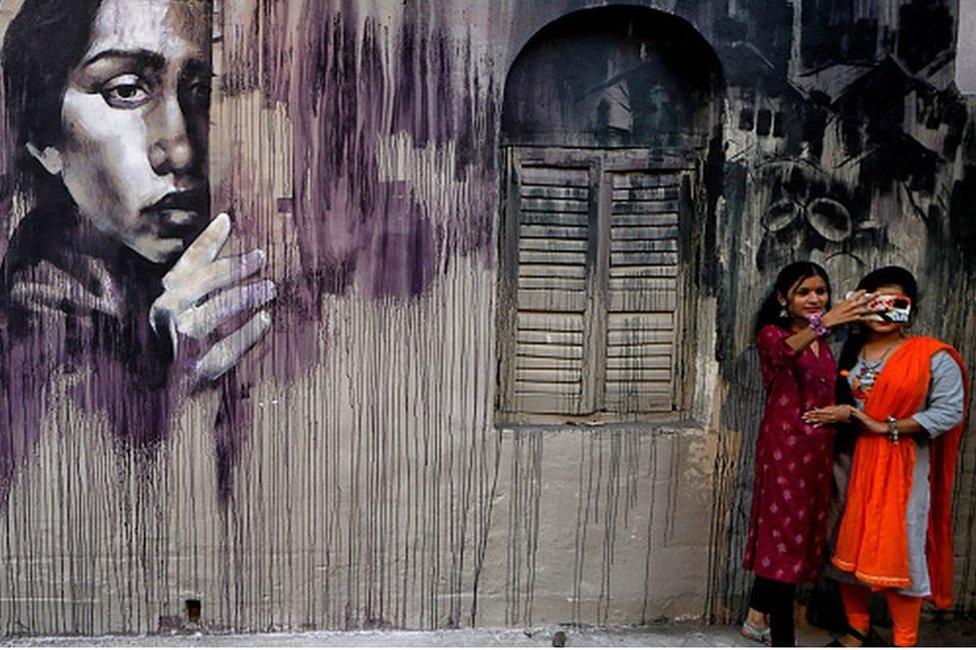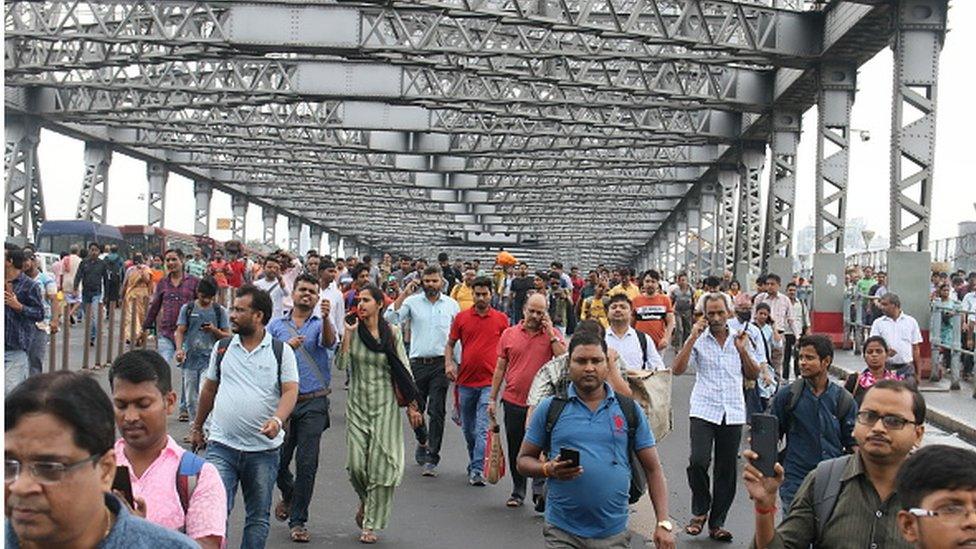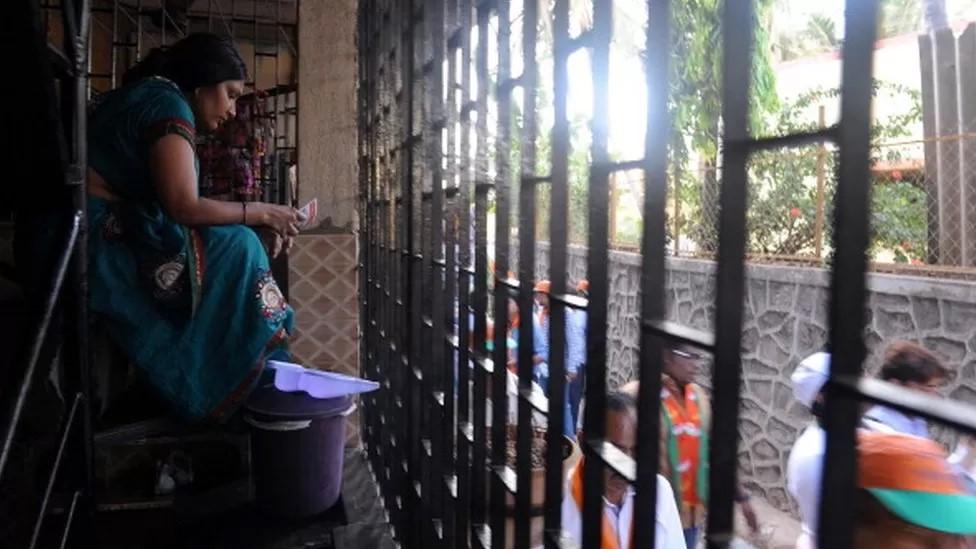Why half of India's urban women stay at home
- Published

India's first Time Series Survey showed women went out considerably less than men
Nineteen-year-old Manisha works as a full-time maid at a house on the outskirts of the Indian capital, Delhi.
Back home in Jharkhand, she dropped out of school as public transport was irregular and sexual harassment on the roads was common. She travelled to the Indian capital, and got herself a job in an apartment. But still she does not venture out much, citing difficulties in commuting and lack of safety.
"I am working but I only go out once or twice a month. I don't feel comfortable on the streets," she says.
Manisha's story wouldn't come as a surprise to Rahul Goel, an assistant professor of transportation research at Delhi's Indian Institute of Technology (IIT). He has used data from India's first Time Use Survey, external - which measures the amount of time people spend doing various activities - to find out more about how gender inequality impacts daily mobility. (Surveyors spread out across India in 2019 collecting information on how people used their time the day before the interview.) In particular, Mr Goel looked at a dataset of 170,000 people living in cities and towns, who were a part of the survey.
The findings were striking. When surveyors visited households, more than half - 53% - of women said they had not stepped outside home the previous day. Only 14% of the men said they had also stayed in.

Researchers say India needs to "feminise" its public spaces and make them safer for women
The study also found that girls were less likely to go out than boys when they were in their adolescence - aged 10 to 19 - and that there was a "slight increase in mobility" when women reached middle age. Mr Goel believes it shows that conservative social norms that restrict women from working outside home, or going out of home at all "start their effect early in childhood".
The study revealed glaring contrasts in gender roles. Women did largely unpaid house work while men spent time in activities outside home. Women, aged 25-44, spent an average of eight-and-a-half hours every day on domestic or caregiving work. Men in the same age group spent less than an hour on these activities. Only 38% of women in this age group reported going out of home, compared to 88% of men.
Being married or living with a person was associated with reduced mobility for women but increased mobility for men. Also women who were married or had an infant went out less; marriage and children had virtually no impact on the mobility for men. "These results are in line with the findings where responsibility of household chores falls disproportionately on females," says Mr Goel.
After reaching working age, more men than women were going out and joining the work force. As people reach the working age of 15, men make the transition from education to work, while this transition happens for a small proportion of women. Only 30% of women who didn't work reported going out of home at least once, compared to 81% of women who were studying or working.

Goa is the "only state which is completely gender equal when it comes to mobility"
"In other words, it is just not that some women are not going out to work, but many are not going out of the house at all," Mr Goel says.
Some of the findings have puzzled experts.
Ashwini Deshpande, a professor of economics at Ashoka University, says there has been a "massive" increase in numbers of girls enrolling for school and college education in India and there's scant evidence of them not showing up for classes. That would mean more women were mobile, and not held back by social norms. "Indian women are definitely not chained to beds and being made to sit at home," she told me.
Prof Deshpande believes Indians also might be "translating" the concept of travel differently in their various languages. "I wouldn't, for example, categorise going to school or college as travel," she says.
Also, low mobility of women cannot be simply explained by social norms or lack of jobs, many believe. For example, women were mobile and very visible on the street in the western city of Pune, which also reports a low rate of women's participation in the work force.
Of course, argues Mr Goel, there are regional variations - there are many more women going out regularly in a number of states. Goa, for example, is the "only state which is completely gender equal when it comes to mobility". Women are out and about in Tamil Nadu, where 43% of India's 1.6 million women engaged in factory work live, according to a study, external. More girls are going out in states like Bihar and West Bengal after a government scheme provided them with free bicycles.

A large number of Indian women are engaged in unpaid chores
Still, India - and some of South Asia - appears to be an outlier.
A 2007 summary of time-use surveys across 15 European countries found that in all countries, except one (Lithuania), women were actually more mobile than men. London reported no gender differences in total number of trips per individual and in France, women made more trips than men.
Another study of 18 cities around the world from Australia, Europe, Latin America, sub-Saharan Africa and North America found that on average 76% of the women reported making a trip compared to 79% of the men. This indicated that the large gender disparity in mobility rate in India is an "outlying phenomenon not commonly observed in most parts of the world", says Mr Goel.
At one level, the findings are unsurprising.
India has a high rate of gender inequality: it has a low sex ratio, labour force participation of women is among the lowest (27%) in the world, and social norms restrict mobility. Many women continue to be sequestered with very few friends, limiting their opportunities to mingle and critique inequalities. At the same time, maternal mortality rates have dropped, fertility levels have fallen, sex ratio at birth is improving slowly and school and college enrolment rates for women have shot up.
Mr Goel says a key barrier is "just about getting women out of the house". One reason is women feel unsafe on the roads which are also not friendly for children and the elderly. "Our public spaces are too masculine. We need to feminise them," he says. There's little dispute about this.
BBC News India is now on YouTube, external. Click here to subscribe and watch our documentaries, explainers and features.

Read more India stories from the BBC:

